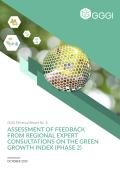The Green Growth Potential Assessment (GGPA) is a diagnostic tool developed by the Global Green Growth Institute (GGGI) that consists of a combination of data analysis and stakeholder consultation in order to identify and prioritise a country’s opportunities for green growth. This report presents the findings of the GGPA for Lao PDR. It reviews in detail the challenges and opportunities across a number of sectors and provides recommendations for each sector.

This report aims to assess how policymakers and other stakeholders understand green growth, why knowledge on green growth diverges across regions, and what common understanding can be integrated in the green growth framework to enhance the relevance of the index for policy decision-making.
The indicator aims to measure the total amount of food that is wasted in tonnes. It complements SDG 12.3.1(a) on Food Loss (which is under the custodianship of FAO) Both indicators look to divide the food value chain and measure the efficiency of the food system.

The Scottish Natural Capital Accounts: 2020 looks at Scottish natural capital assets, the flows and values of services to help measure aspects of the natural world and their impact upon people.
This assessment was aimed to provide United Nations regulators, international, regional, national and local decision-makers with predictive knowledge and a management tool on contaminants trends worldwide to support decisions of socio-economic value at all scales. This report contains a detailed description of the established methodology, an overall description of the database, six case studies among the Large Marine Ecosystems (LMEs; selected based on geographic distribution and information availability), a global assessment, conclusions, and recommendations.
